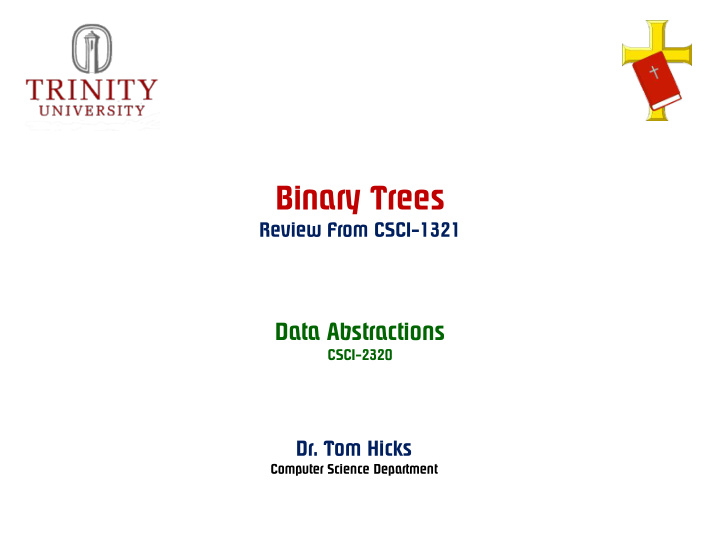



Binary Trees Review From CSCI-1321 Data Abstractions CSCI-2320 Dr. Tom Hicks Computer Science Department
Root Root Node - A Node Without A Parent. Root Root 3
Leaf Leaf Node - A Node Without Children. Leaf Leaf 5
Ancestors {D,11} - Nodes In The Path(s) To The Root. B, F Ancestors Of D 5, 2, 1 Ancestors Of 11 7
Descendants {B,6} - Nodes In The Path(s) To The Leaves. A,D,C,E Descendants Of B 12,13,24,25,26,27 Descendants Of 6 9
Skew Trees Skew Tree - A Tree With No More Than 1 Node At Each Level. Empty Tree A Skew Tree Has The Same Performance As A Linked List! 11
Full/Perfect Binary Trees Full Tree - A Tree In Which The Lowest Level Is Fully Populated Every Node, Other Than The Leaves, Has Two Children. Empty Tree Best Case Tree! Also Called A "Perfect" Tree 13
Height Of Tree Height Of A Tree Is The Number Of Edges In The Longest Path From The Root To A Leaf Node Height Height = 5 15
No Levels On A Tree Some Start With 0 Others With 1 WE ARE GOING TO USE 1 Level 1 Level 2 Height Level 3 Level 4 Level 5 Level 6 Height = 5 17
Perfect/Full Trees NL No Levels - 1 Max Nodes Perfect Tree NL = 2 2 NL - 1 = 2 2 - 1 = 3 2 NL - 1 = 2 3 - 1 = 7 19
Perfect/Full Trees NL No Levels - 2 Max Nodes Perfect Tree NL = 4 2 NL - 1 = 2 4 - 1 = 15 Height Of Perfect Binary Tree With 15 Nodes = Log 2 (15) = ~4 20
Perfect/Full Trees NL No Levels - 3 Max Nodes Perfect Tree NL = 5 2 NL - 1 = 2 5 - 1 = 31 Height Of Perfect Binary Tree With 15 Nodes = Log 2 (31) = ~5 21
Average Search = Total Searches / No Nodes Compute # Searches 1 1 4 2 2 3 3 3 9 12 4 4 4 ___ 26 26/9 = 2.89 23
Balanced Binary Tree A Balanced Tree is one that cannot be expressed in fewer levels; it will have the lowest Average Search for that number of Nodes. 25
Inorder Traversal Left Root Right There Are Recursive & Non-Recursive Solutions! Preorder Traversal Root Left Right There Are Recursive & Non-Recursive Solutions! Postorder Traversal Left Right Root There Are Recursive & Non-Recursive Solutions! 26
Recursive Solutions Are Quite Easy To Code Traverse The Left Visit The Root Traverse The Right 27
Inorder Traversal D B H E I A F C G 28
Inorder Traversal D B H E I A F C G H D I B J E K A L F C G 29
Preorder Traversal A B D E H I C F G A B D H I E J K C F L G 30
Postorder Traversal D H I E B F G C A H I D J K E B L F G C A 31
Data Abstractions CSCI 2320 Dr. Thomas E. Hicks Computer Science Department Trinity University Textbook: Introduction To Algorithms 3 rd Edition By Cormen, Leiserson, Rivest, Stein Textbook: A Tour Of C++ By Bjarne Stroustrup Special Thanks To For MIT Press & Adison Wesley For Content & Graphics That Are Relevant To This Presentation. 32
Average Search = Total Searches / No Nodes 100 150 50 125 175 75 25 40 25 40 50 75 100 125 150 175
Recommend
More recommend